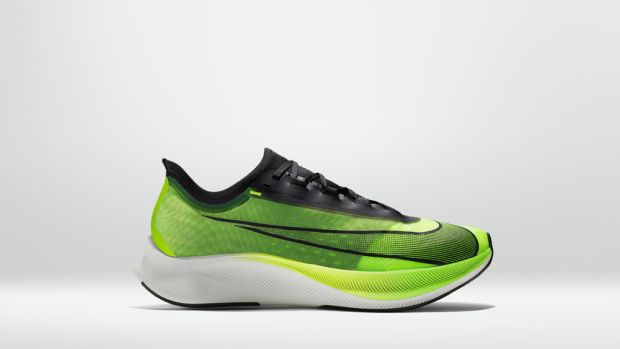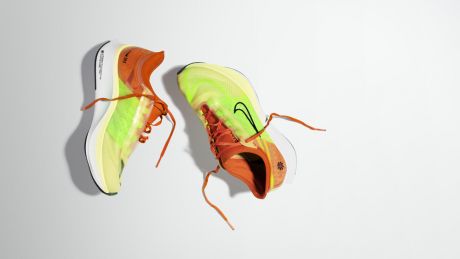You can trust Coach
It’s impossible to talk about the shoe the Nike Zoom Fly 3 is without talking about the shoes it isn’t, namely the Nike Zoom Vaporfly 4% and NEXT%. Those are Nike’s top-end long-distance racing shoes that have helped elites and amateurs alike set PBs in recent years.
The Vaporfly is an astonishing shoe, in terms of both performance and price. The NEXT% is £239.95 and the 4% is £209.95, and both shoes prioritise performance over durability, so they’re best saved for your most important race days.
That leaves an opening for another shoe, one that gives a flavour of the performance of the Vaporfly while being much cheaper and longer-lasting, and that’s the Zoom Fly 3 to a T. Like the Vaporfly it has a carbon plate in its midsole and is designed for fast running; however, it costs a relatively paltry £139.95, while the React foam in its midsole is much more durable than the ZoomX foam used in the Vaporfly.
I’ve used all three editions of the Zoom Fly and while this is the best yet, it’s also the one I’m most reluctant to recommend buying. That’s because two other current shoes better fulfil the Zoom Fly’s purpose: the Hoka Carbon X also has a carbon plate in its midsole, while the New Balance FuelCell Rebel is a terrific, lightweight shoe that can be used for training and racing, and is the cheapest of the three.
That’s not to say the Zoom Fly 3 isn’t a great running shoe. I used it for a variety of fast running sessions, including track and tempo, as well as a 22km run at a decent clip. The further I ran in it, the more I appreciated its qualities: the carbon plate and bouncy React foam help maintain a quick pace with what feels like less effort, with a smooth transition from heel to toe and a propulsive toe-off powered by the plate in the midsole.

On shorter runs and during track intervals, on the other hand, I was less taken with the Zoom Fly 3. It’s just a little too much shoe to feel nimble at speed, with the chunky stack of React foam feeling cumbersome and a little heavy. This is one area where I feel the Hoka Carbon X has the edge on the Zoom Fly 3. It also has a large stack of cushioning and the shoes both weigh around 250g (men’s), but the Carbon X feels snappier and lighter on the foot for short and speedy runs.
The same is true of the New Balance Rebel, which doesn’t have a carbon plate but with the FuelCell foam in its midsole it has a faster feel than the Zoom Fly 3, and it’s also much lighter at just over 200g. Another point in the Rebel’s favour is that it’s cheaper at £120, while the Hoka Carbon X is £159.99.
Sign up for workout ideas, training advice, reviews of the latest gear and more.
I did like the new upper on the Zoom Fly 3, which is the most substantial update to the shoe. The previous version used a Flyknit upper which tends to absorb water and stretch a little over time, losing the close fit you want when running fast. The upper on the Zoom Fly 3 doesn’t seem as paper-thin as the one on the NEXT%, even though both are made with the same Vaporweave material, but it does offer a true-to-size fit and doesn’t retain water.
If you have the Vaporfly 4% or NEXT% for racing and simply want the closest possible shoe to use for fast training, the Zoom Fly 3 fits the bill. If you’re looking at it purely on its own merits as a cheaper alternative to the Vaporfly, there are better options. Hoka’s Carbon X has the carbon plate that everyone wants these days and feels lighter on the foot than the Zoom Fly, while the New Balance Rebel is just a great all-round shoe that’s fun to run fast in at any distance.
Buy men’s from Nike | Buy women’s from Nike | £139.95

Nick Harris-Fry is a journalist who has been covering health and fitness since 2015. Nick is an avid runner, covering 70-110km a week, which gives him ample opportunity to test a wide range of running shoes and running gear. He is also the chief tester for fitness trackers and running watches, treadmills and exercise bikes, and workout headphones.

